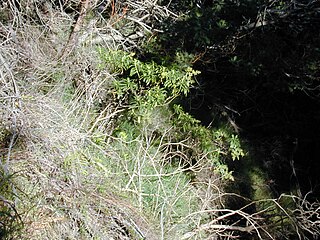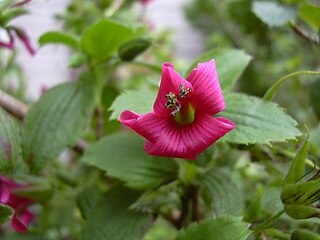
Delissea rhytidosperma, is known by the common names Kauai delissea, Kauai leechleaf delissea, and leechleaf delissea. It is a rare species of flowering plant in the bellflower family, that is endemic to Hawaii where it is known only from the island of Kauai. It is critically endangered or extinct in the wild.

Dubautia plantaginea is a rare species of flowering plant in the aster family known by the common name plantainleaf dubautia. It is endemic to Hawaii where it is the only member of the silversword alliance that is found on all six of the largest islands. Two of the three subspecies are rare and endangered. Like other Dubautia this plant is called na`ena`e.
Exocarpos luteolus is a rare species of flowering plant in the sandalwood family known by the common names leafy ballart or heau. It is endemic to Hawaii, where it is known only from the island of Kauai. There are eight populations remaining, for a total global population of only 39 individuals. The plant was federally listed as an endangered species of the United States in 1994.

Geranium arboreum is a rare species of geranium known by the common names Hawaiian red-flowered geranium and Hawaii red cranesbill. It is endemic to Hawaii, where it is known only from the island of Maui. It was federally listed as an endangered species in 1992. Like other Hawaiian geraniums, this plant is known as hinahina and nohoanu.

Kadua coriacea is a rare species of flowering plant in the coffee family known by the common name kioʻele. It is endemic to Hawaii, where it is known only from the island of Hawaiʻi and one individual remaining on Maui. It is a federally listed endangered species of the United States.

Isodendrion laurifolium is a rare species of flowering plant in the violet family known by the common names rockcliff isodendrion and aupaka. It is endemic to Hawaii, where it is known from fewer than 1000 individuals on the islands of Kauai and Oahu. It is a federally listed endangered species of the United States.
Isodendrion longifolium is a rare species of flowering plant in the violet family known by the common names longleaf isodendrion and aupaka. It is endemic to Hawaii, where it is known from fewer than 1000 individuals on the islands of Kauai and Oahu. It is a federally listed threatened species of the United States.

Isodendrion pyrifolium is a rare species of flowering plant in the violet family known by the common name wahine noho kula. It is endemic to Hawaii, where it is known only from the island of Hawaii. It is a federally listed endangered species of the United States.

Lysimachia iniki is a rare species of flowering plant in the family Primulaceae known by the common names Wailua River yellow loosestrife and Wailua River island-loosestrife. It is endemic to Hawaii, where there is only one known occurrence existing on the island of Kauai. The plant was federally listed as an endangered species of the United States in 2010.
Lysimachia pendens is a rare species of flowering plant in the family Primulaceae known by the common name broad-leaf yellow loosestrife. It is endemic to Hawaii, where there is a single occurrence known on the island of Kauai. It was federally listed as an endangered species of the United States in 2010.
Lysimachia scopulensis is a rare species of flowering plant in the family Primulaceae known by the common name shiny-leaf yellow loosestrife. It is endemic to Hawaii, where there are two small populations on the island of Kauai. It was federally listed as an endangered species of the United States in 2010.
Melicope munroi is a rare species of flowering plant in the family Rutaceae known by the common names lanahale and Munro's pelea. It is endemic to Hawaii, where it is known only from the island of Lanai. It is a federally listed endangered species of the United States. Like other Hawaiian Melicope, this species is known as alani.
Melicope rostrata, synonym Platydesma rostrata, is a rare species of flowering plant in the citrus family, known by the common name pilo kea lau li'i. It is endemic to Hawaii, where there are only about 100 individuals remaining on island of Kauai. It was federally listed as an endangered species of the United States in 2010.
Schiedea apokremnos is a rare species of flowering plant in the family Caryophyllaceae known by the common names Kauai schiedea, Na Pali Coast schiedea, and ma`oli`oli. It is endemic to Hawaii, where it is known only from the island of Kauai. It is threatened by the degradation of its habitat. It is a federally listed endangered species of the United States.
Schiedea attenuata is a rare species of flowering plant in the family Caryophyllaceae known by the common name Kalalau schiedea. It is endemic to Hawaii, where it is known only from the Kalalau Valley on the island of Kauai. It is threatened by the degradation of its habitat. It was federally listed as an endangered species of the United States in 2010.

Schiedea haleakalensis is a rare species of flowering plant in the family Caryophyllaceae known by the common name Haleakalā schiedea. It is endemic to Hawaii, where it is known only from Haleakalā National Park on the island of Maui. It is threatened by the degradation of its habitat. It was federally listed as an endangered species of the United States in 1992. Its native habitat includes dry subalpine cliffs with native shrubs.

Schiedea hookeri is a rare species of flowering plant in the family Caryophyllaceae known by the common names Hooker's schiedea and sprawling schiedea. It is endemic to Hawaii, where it is known only from the island of Oahu. It is thought to have been extirpated from Haleakalā on Maui. It is threatened by the degradation and destruction of its habitat. It was federally listed as an endangered species of the United States in 1996.
Tetramolopium arenarium is a rare species of flowering plant in the family Asteraceae known by the common name Maui tetramolopium. It is endemic to Hawaii, where it is known only from the island of Hawaii. It is extirpated from Maui. It is threatened by the degradation of its habitat. It is a federally listed endangered species of the United States.
Tetramolopium remyi is a rare species of flowering plant in the family Asteraceae known by the common names Awalua Ridge tetramolopium and Remy's tetramolopium. It is endemic to Hawaii, where today it is known only from the island of Lanai. It is believed to be extirpated on the island of Maui, having not been observed there since 1944. It is threatened by habitat degradation caused by deer, Mouflon, and introduced species of plants. It is a federally listed endangered species of the United States.
Trematolobelia singularis, the lavaslope false lobelia, is a rare species of flowering plant in the bellflower family. It is endemic to Hawaii, where it is known only from the Koʻolau Range on the island of Oahu. It is threatened by the degradation of its habitat. It is a federally listed endangered species of the United States.









